Hospitality Decision-Making: B2B vs B2C & Market Research Approaches
VerifiedAdded on 2022/12/27
|13
|3913
|52
Report
AI Summary
This report delves into the multifaceted realm of tourism consumer behaviour, examining the various factors that influence consumer decisions in the tourism sector, including cultural, personal, social, and psychological aspects. It investigates how digital technology has reshaped consumer trends, expectations, and access to information, highlighting the importance of online presence for tourism businesses. The report outlines the stages of consumer decision-making, from problem recognition to post-purchase evaluation, and maps the path to purchase in the context of tourism, emphasizing the significance of understanding consumer needs and preferences. Furthermore, it compares the key differences between B2B and B2C decision-making processes in the hospitality industry and evaluates different approaches to market research for understanding consumer behaviour. Finally, the report assesses how marketers can effectively influence various stages of the tourism decision-making process, providing valuable insights for tourism businesses seeking to enhance customer satisfaction and drive growth. Desklib provides a platform for students to access this assignment and other study tools.
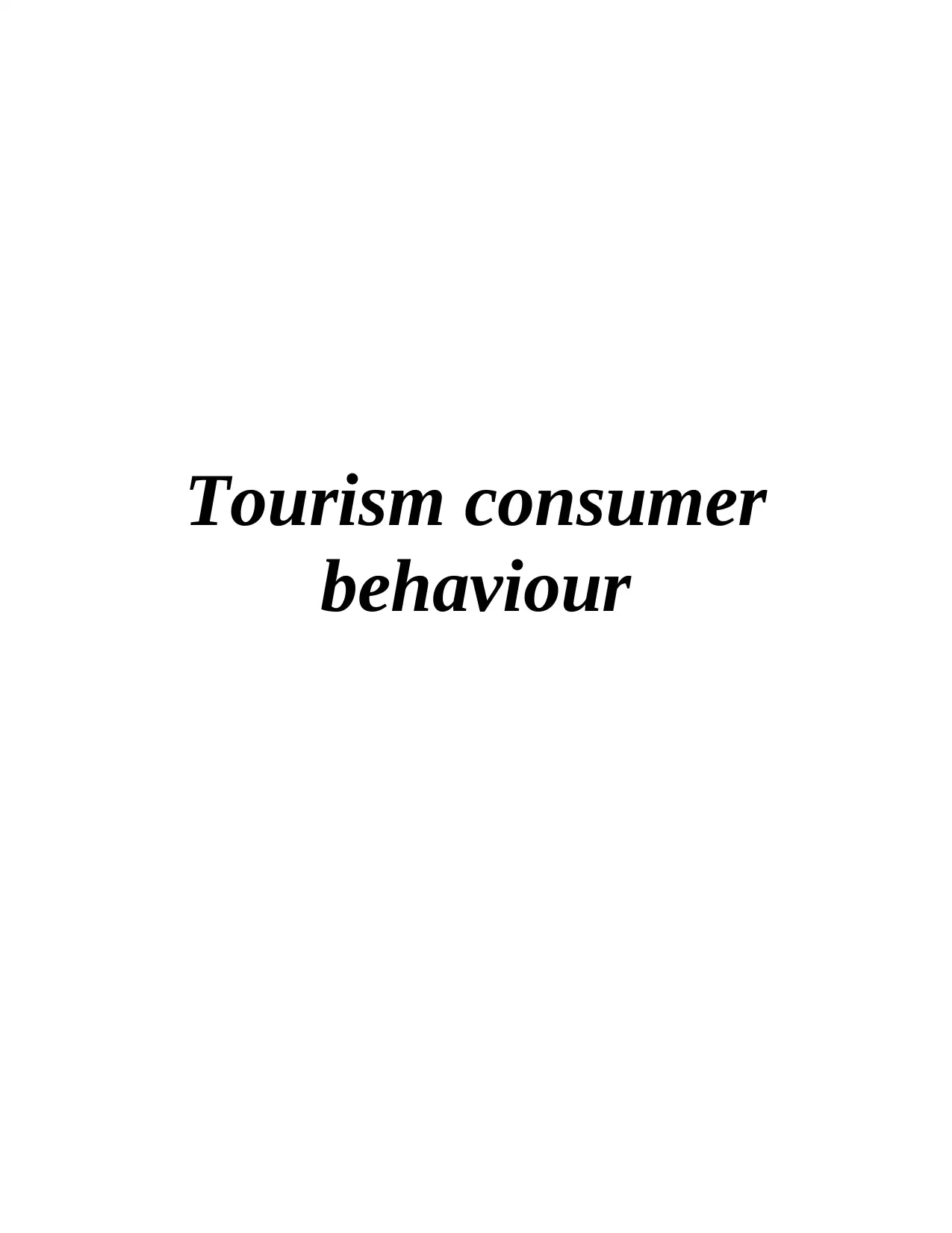
Tourism consumer
behaviour
behaviour
Paraphrase This Document
Need a fresh take? Get an instant paraphrase of this document with our AI Paraphraser
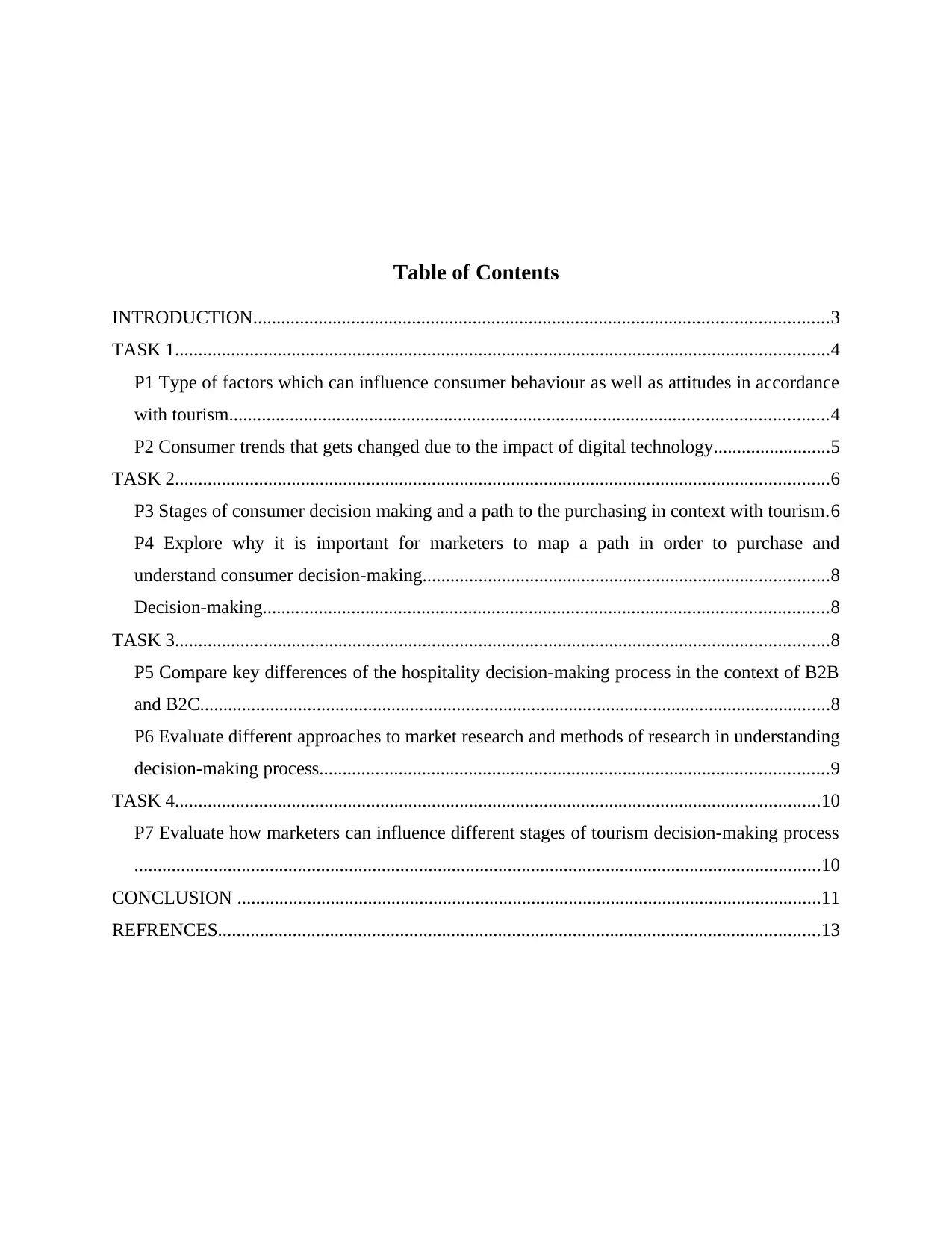
Table of Contents
INTRODUCTION...........................................................................................................................3
TASK 1............................................................................................................................................4
P1 Type of factors which can influence consumer behaviour as well as attitudes in accordance
with tourism................................................................................................................................4
P2 Consumer trends that gets changed due to the impact of digital technology.........................5
TASK 2............................................................................................................................................6
P3 Stages of consumer decision making and a path to the purchasing in context with tourism.6
P4 Explore why it is important for marketers to map a path in order to purchase and
understand consumer decision-making.......................................................................................8
Decision-making.........................................................................................................................8
TASK 3............................................................................................................................................8
P5 Compare key differences of the hospitality decision-making process in the context of B2B
and B2C.......................................................................................................................................8
P6 Evaluate different approaches to market research and methods of research in understanding
decision-making process.............................................................................................................9
TASK 4..........................................................................................................................................10
P7 Evaluate how marketers can influence different stages of tourism decision-making process
...................................................................................................................................................10
CONCLUSION .............................................................................................................................11
REFRENCES.................................................................................................................................13
INTRODUCTION...........................................................................................................................3
TASK 1............................................................................................................................................4
P1 Type of factors which can influence consumer behaviour as well as attitudes in accordance
with tourism................................................................................................................................4
P2 Consumer trends that gets changed due to the impact of digital technology.........................5
TASK 2............................................................................................................................................6
P3 Stages of consumer decision making and a path to the purchasing in context with tourism.6
P4 Explore why it is important for marketers to map a path in order to purchase and
understand consumer decision-making.......................................................................................8
Decision-making.........................................................................................................................8
TASK 3............................................................................................................................................8
P5 Compare key differences of the hospitality decision-making process in the context of B2B
and B2C.......................................................................................................................................8
P6 Evaluate different approaches to market research and methods of research in understanding
decision-making process.............................................................................................................9
TASK 4..........................................................................................................................................10
P7 Evaluate how marketers can influence different stages of tourism decision-making process
...................................................................................................................................................10
CONCLUSION .............................................................................................................................11
REFRENCES.................................................................................................................................13
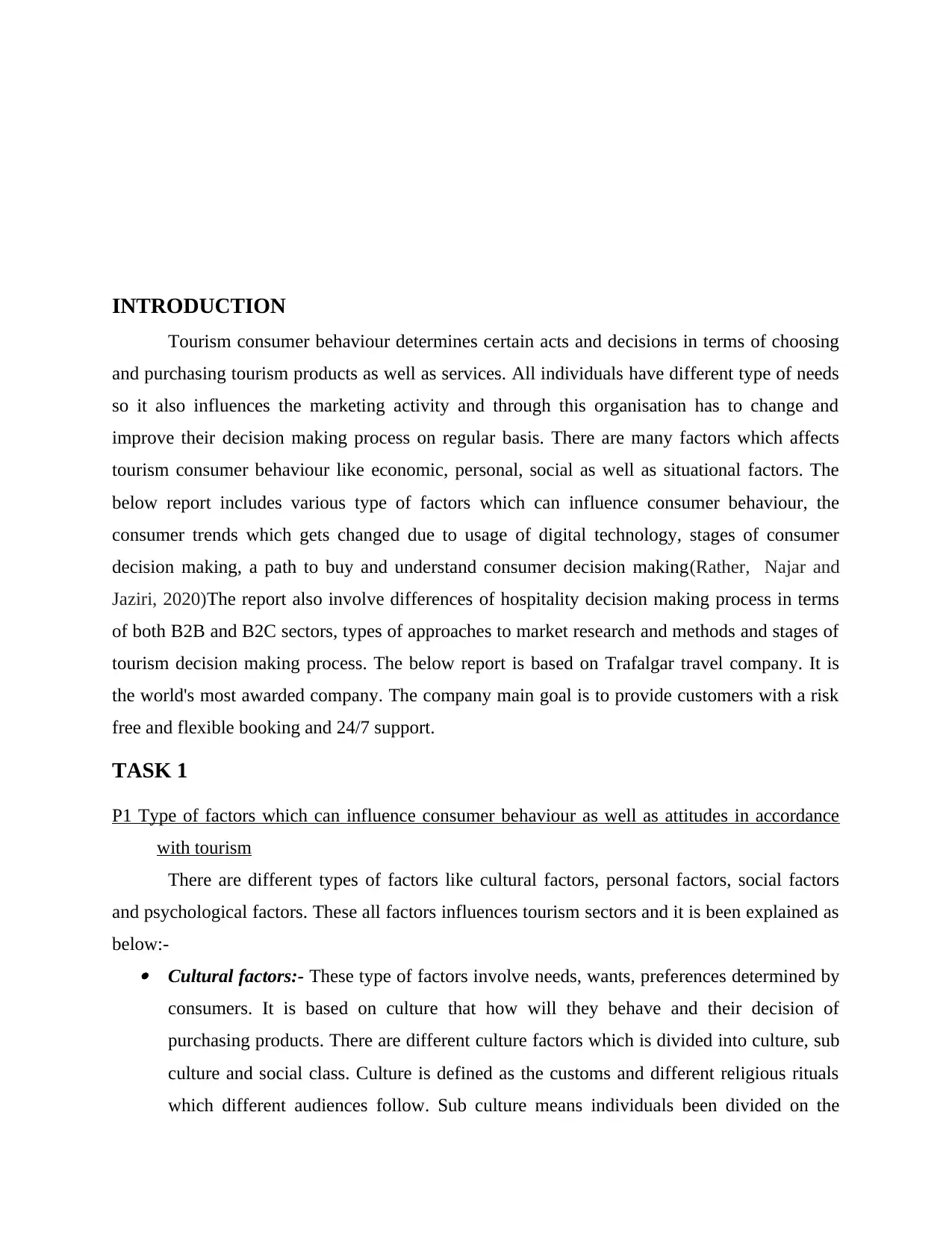
INTRODUCTION
Tourism consumer behaviour determines certain acts and decisions in terms of choosing
and purchasing tourism products as well as services. All individuals have different type of needs
so it also influences the marketing activity and through this organisation has to change and
improve their decision making process on regular basis. There are many factors which affects
tourism consumer behaviour like economic, personal, social as well as situational factors. The
below report includes various type of factors which can influence consumer behaviour, the
consumer trends which gets changed due to usage of digital technology, stages of consumer
decision making, a path to buy and understand consumer decision making(Rather, Najar and
Jaziri, 2020)The report also involve differences of hospitality decision making process in terms
of both B2B and B2C sectors, types of approaches to market research and methods and stages of
tourism decision making process. The below report is based on Trafalgar travel company. It is
the world's most awarded company. The company main goal is to provide customers with a risk
free and flexible booking and 24/7 support.
TASK 1
P1 Type of factors which can influence consumer behaviour as well as attitudes in accordance
with tourism
There are different types of factors like cultural factors, personal factors, social factors
and psychological factors. These all factors influences tourism sectors and it is been explained as
below:- Cultural factors:- These type of factors involve needs, wants, preferences determined by
consumers. It is based on culture that how will they behave and their decision of
purchasing products. There are different culture factors which is divided into culture, sub
culture and social class. Culture is defined as the customs and different religious rituals
which different audiences follow. Sub culture means individuals been divided on the
Tourism consumer behaviour determines certain acts and decisions in terms of choosing
and purchasing tourism products as well as services. All individuals have different type of needs
so it also influences the marketing activity and through this organisation has to change and
improve their decision making process on regular basis. There are many factors which affects
tourism consumer behaviour like economic, personal, social as well as situational factors. The
below report includes various type of factors which can influence consumer behaviour, the
consumer trends which gets changed due to usage of digital technology, stages of consumer
decision making, a path to buy and understand consumer decision making(Rather, Najar and
Jaziri, 2020)The report also involve differences of hospitality decision making process in terms
of both B2B and B2C sectors, types of approaches to market research and methods and stages of
tourism decision making process. The below report is based on Trafalgar travel company. It is
the world's most awarded company. The company main goal is to provide customers with a risk
free and flexible booking and 24/7 support.
TASK 1
P1 Type of factors which can influence consumer behaviour as well as attitudes in accordance
with tourism
There are different types of factors like cultural factors, personal factors, social factors
and psychological factors. These all factors influences tourism sectors and it is been explained as
below:- Cultural factors:- These type of factors involve needs, wants, preferences determined by
consumers. It is based on culture that how will they behave and their decision of
purchasing products. There are different culture factors which is divided into culture, sub
culture and social class. Culture is defined as the customs and different religious rituals
which different audiences follow. Sub culture means individuals been divided on the
⊘ This is a preview!⊘
Do you want full access?
Subscribe today to unlock all pages.

Trusted by 1+ million students worldwide
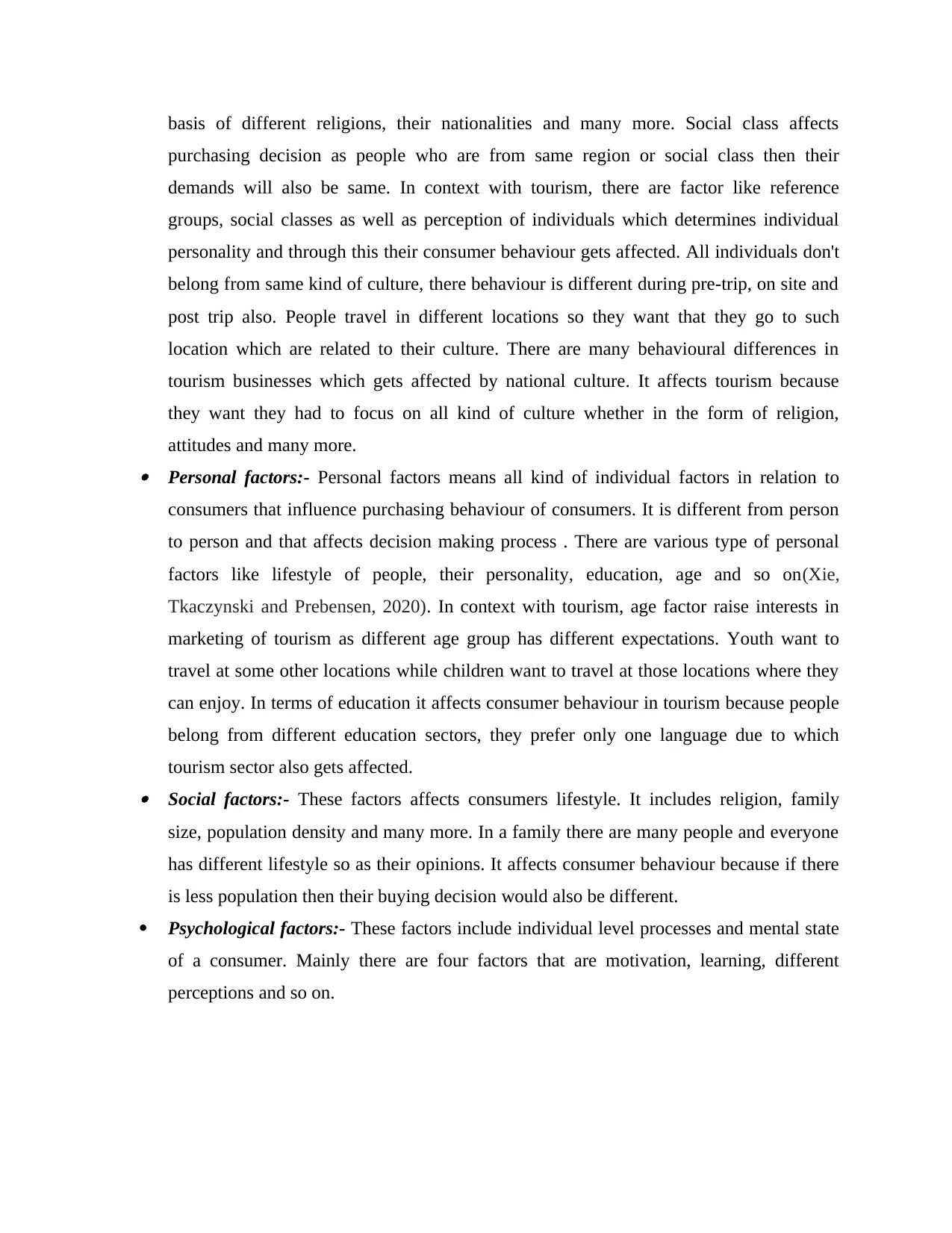
basis of different religions, their nationalities and many more. Social class affects
purchasing decision as people who are from same region or social class then their
demands will also be same. In context with tourism, there are factor like reference
groups, social classes as well as perception of individuals which determines individual
personality and through this their consumer behaviour gets affected. All individuals don't
belong from same kind of culture, there behaviour is different during pre-trip, on site and
post trip also. People travel in different locations so they want that they go to such
location which are related to their culture. There are many behavioural differences in
tourism businesses which gets affected by national culture. It affects tourism because
they want they had to focus on all kind of culture whether in the form of religion,
attitudes and many more. Personal factors:- Personal factors means all kind of individual factors in relation to
consumers that influence purchasing behaviour of consumers. It is different from person
to person and that affects decision making process . There are various type of personal
factors like lifestyle of people, their personality, education, age and so on(Xie,
Tkaczynski and Prebensen, 2020). In context with tourism, age factor raise interests in
marketing of tourism as different age group has different expectations. Youth want to
travel at some other locations while children want to travel at those locations where they
can enjoy. In terms of education it affects consumer behaviour in tourism because people
belong from different education sectors, they prefer only one language due to which
tourism sector also gets affected. Social factors:- These factors affects consumers lifestyle. It includes religion, family
size, population density and many more. In a family there are many people and everyone
has different lifestyle so as their opinions. It affects consumer behaviour because if there
is less population then their buying decision would also be different.
Psychological factors:- These factors include individual level processes and mental state
of a consumer. Mainly there are four factors that are motivation, learning, different
perceptions and so on.
purchasing decision as people who are from same region or social class then their
demands will also be same. In context with tourism, there are factor like reference
groups, social classes as well as perception of individuals which determines individual
personality and through this their consumer behaviour gets affected. All individuals don't
belong from same kind of culture, there behaviour is different during pre-trip, on site and
post trip also. People travel in different locations so they want that they go to such
location which are related to their culture. There are many behavioural differences in
tourism businesses which gets affected by national culture. It affects tourism because
they want they had to focus on all kind of culture whether in the form of religion,
attitudes and many more. Personal factors:- Personal factors means all kind of individual factors in relation to
consumers that influence purchasing behaviour of consumers. It is different from person
to person and that affects decision making process . There are various type of personal
factors like lifestyle of people, their personality, education, age and so on(Xie,
Tkaczynski and Prebensen, 2020). In context with tourism, age factor raise interests in
marketing of tourism as different age group has different expectations. Youth want to
travel at some other locations while children want to travel at those locations where they
can enjoy. In terms of education it affects consumer behaviour in tourism because people
belong from different education sectors, they prefer only one language due to which
tourism sector also gets affected. Social factors:- These factors affects consumers lifestyle. It includes religion, family
size, population density and many more. In a family there are many people and everyone
has different lifestyle so as their opinions. It affects consumer behaviour because if there
is less population then their buying decision would also be different.
Psychological factors:- These factors include individual level processes and mental state
of a consumer. Mainly there are four factors that are motivation, learning, different
perceptions and so on.
Paraphrase This Document
Need a fresh take? Get an instant paraphrase of this document with our AI Paraphraser
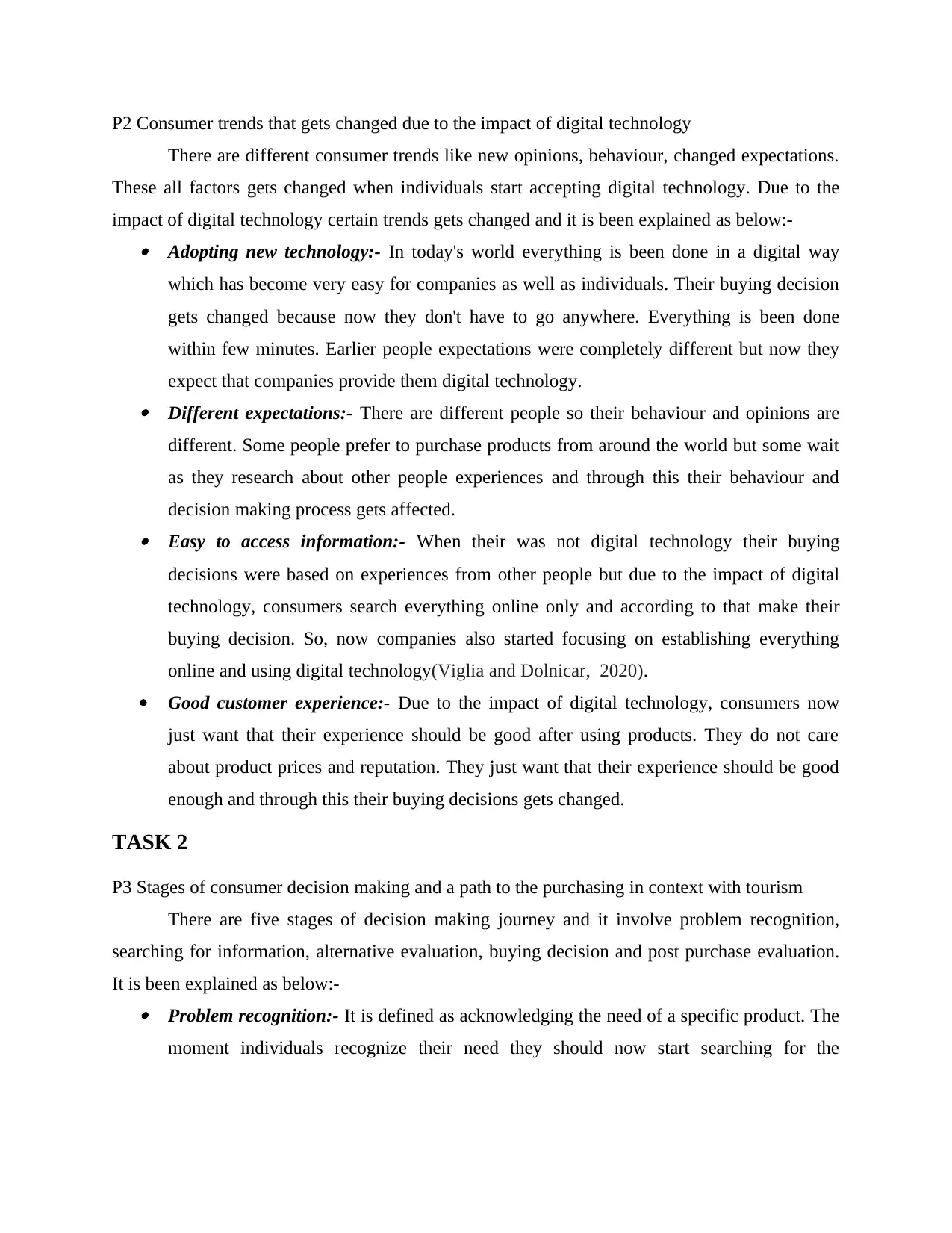
P2 Consumer trends that gets changed due to the impact of digital technology
There are different consumer trends like new opinions, behaviour, changed expectations.
These all factors gets changed when individuals start accepting digital technology. Due to the
impact of digital technology certain trends gets changed and it is been explained as below:- Adopting new technology:- In today's world everything is been done in a digital way
which has become very easy for companies as well as individuals. Their buying decision
gets changed because now they don't have to go anywhere. Everything is been done
within few minutes. Earlier people expectations were completely different but now they
expect that companies provide them digital technology. Different expectations:- There are different people so their behaviour and opinions are
different. Some people prefer to purchase products from around the world but some wait
as they research about other people experiences and through this their behaviour and
decision making process gets affected. Easy to access information:- When their was not digital technology their buying
decisions were based on experiences from other people but due to the impact of digital
technology, consumers search everything online only and according to that make their
buying decision. So, now companies also started focusing on establishing everything
online and using digital technology(Viglia and Dolnicar, 2020).
Good customer experience:- Due to the impact of digital technology, consumers now
just want that their experience should be good after using products. They do not care
about product prices and reputation. They just want that their experience should be good
enough and through this their buying decisions gets changed.
TASK 2
P3 Stages of consumer decision making and a path to the purchasing in context with tourism
There are five stages of decision making journey and it involve problem recognition,
searching for information, alternative evaluation, buying decision and post purchase evaluation.
It is been explained as below:- Problem recognition:- It is defined as acknowledging the need of a specific product. The
moment individuals recognize their need they should now start searching for the
There are different consumer trends like new opinions, behaviour, changed expectations.
These all factors gets changed when individuals start accepting digital technology. Due to the
impact of digital technology certain trends gets changed and it is been explained as below:- Adopting new technology:- In today's world everything is been done in a digital way
which has become very easy for companies as well as individuals. Their buying decision
gets changed because now they don't have to go anywhere. Everything is been done
within few minutes. Earlier people expectations were completely different but now they
expect that companies provide them digital technology. Different expectations:- There are different people so their behaviour and opinions are
different. Some people prefer to purchase products from around the world but some wait
as they research about other people experiences and through this their behaviour and
decision making process gets affected. Easy to access information:- When their was not digital technology their buying
decisions were based on experiences from other people but due to the impact of digital
technology, consumers search everything online only and according to that make their
buying decision. So, now companies also started focusing on establishing everything
online and using digital technology(Viglia and Dolnicar, 2020).
Good customer experience:- Due to the impact of digital technology, consumers now
just want that their experience should be good after using products. They do not care
about product prices and reputation. They just want that their experience should be good
enough and through this their buying decisions gets changed.
TASK 2
P3 Stages of consumer decision making and a path to the purchasing in context with tourism
There are five stages of decision making journey and it involve problem recognition,
searching for information, alternative evaluation, buying decision and post purchase evaluation.
It is been explained as below:- Problem recognition:- It is defined as acknowledging the need of a specific product. The
moment individuals recognize their need they should now start searching for the
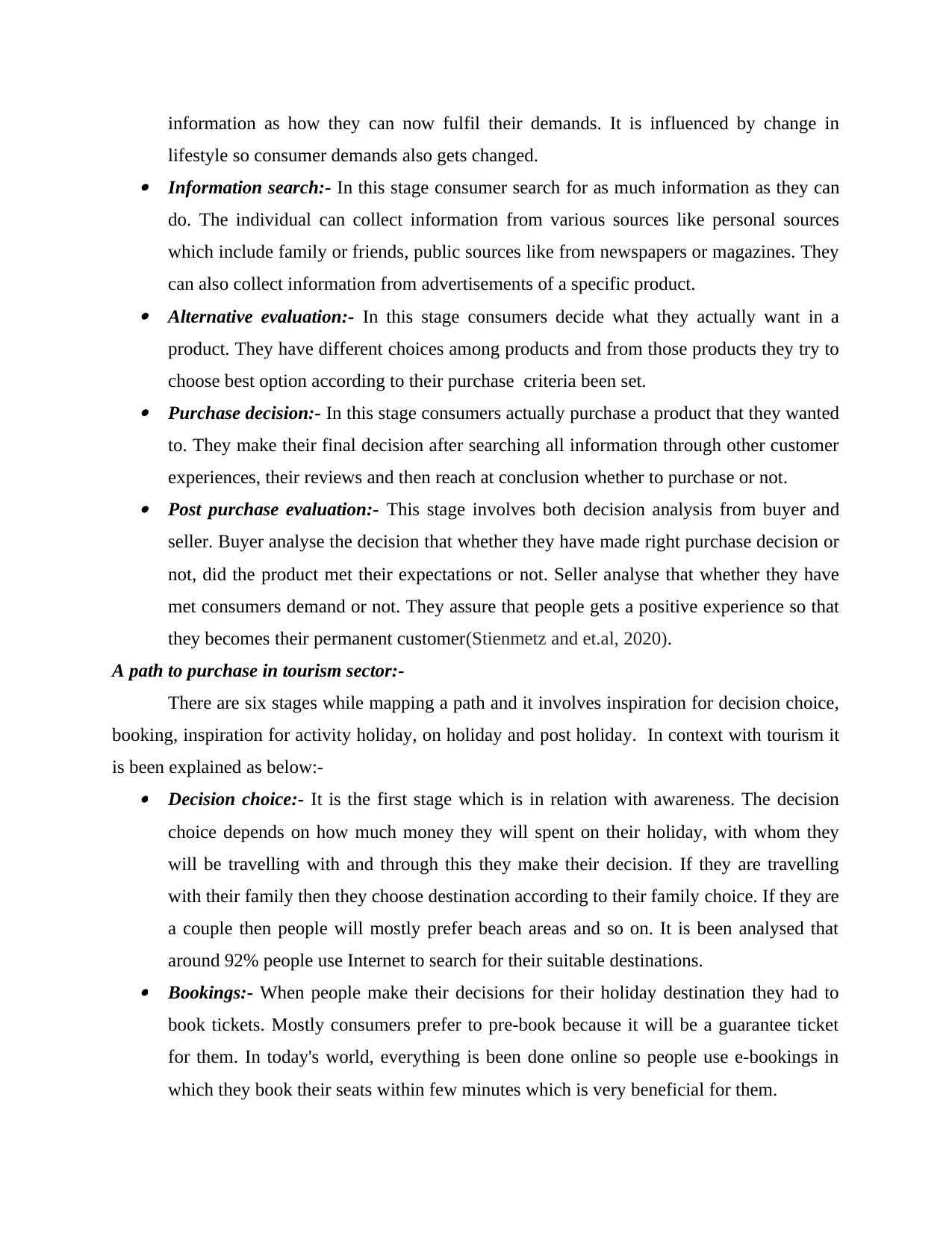
information as how they can now fulfil their demands. It is influenced by change in
lifestyle so consumer demands also gets changed. Information search:- In this stage consumer search for as much information as they can
do. The individual can collect information from various sources like personal sources
which include family or friends, public sources like from newspapers or magazines. They
can also collect information from advertisements of a specific product. Alternative evaluation:- In this stage consumers decide what they actually want in a
product. They have different choices among products and from those products they try to
choose best option according to their purchase criteria been set. Purchase decision:- In this stage consumers actually purchase a product that they wanted
to. They make their final decision after searching all information through other customer
experiences, their reviews and then reach at conclusion whether to purchase or not. Post purchase evaluation:- This stage involves both decision analysis from buyer and
seller. Buyer analyse the decision that whether they have made right purchase decision or
not, did the product met their expectations or not. Seller analyse that whether they have
met consumers demand or not. They assure that people gets a positive experience so that
they becomes their permanent customer(Stienmetz and et.al, 2020).
A path to purchase in tourism sector:-
There are six stages while mapping a path and it involves inspiration for decision choice,
booking, inspiration for activity holiday, on holiday and post holiday. In context with tourism it
is been explained as below:- Decision choice:- It is the first stage which is in relation with awareness. The decision
choice depends on how much money they will spent on their holiday, with whom they
will be travelling with and through this they make their decision. If they are travelling
with their family then they choose destination according to their family choice. If they are
a couple then people will mostly prefer beach areas and so on. It is been analysed that
around 92% people use Internet to search for their suitable destinations. Bookings:- When people make their decisions for their holiday destination they had to
book tickets. Mostly consumers prefer to pre-book because it will be a guarantee ticket
for them. In today's world, everything is been done online so people use e-bookings in
which they book their seats within few minutes which is very beneficial for them.
lifestyle so consumer demands also gets changed. Information search:- In this stage consumer search for as much information as they can
do. The individual can collect information from various sources like personal sources
which include family or friends, public sources like from newspapers or magazines. They
can also collect information from advertisements of a specific product. Alternative evaluation:- In this stage consumers decide what they actually want in a
product. They have different choices among products and from those products they try to
choose best option according to their purchase criteria been set. Purchase decision:- In this stage consumers actually purchase a product that they wanted
to. They make their final decision after searching all information through other customer
experiences, their reviews and then reach at conclusion whether to purchase or not. Post purchase evaluation:- This stage involves both decision analysis from buyer and
seller. Buyer analyse the decision that whether they have made right purchase decision or
not, did the product met their expectations or not. Seller analyse that whether they have
met consumers demand or not. They assure that people gets a positive experience so that
they becomes their permanent customer(Stienmetz and et.al, 2020).
A path to purchase in tourism sector:-
There are six stages while mapping a path and it involves inspiration for decision choice,
booking, inspiration for activity holiday, on holiday and post holiday. In context with tourism it
is been explained as below:- Decision choice:- It is the first stage which is in relation with awareness. The decision
choice depends on how much money they will spent on their holiday, with whom they
will be travelling with and through this they make their decision. If they are travelling
with their family then they choose destination according to their family choice. If they are
a couple then people will mostly prefer beach areas and so on. It is been analysed that
around 92% people use Internet to search for their suitable destinations. Bookings:- When people make their decisions for their holiday destination they had to
book tickets. Mostly consumers prefer to pre-book because it will be a guarantee ticket
for them. In today's world, everything is been done online so people use e-bookings in
which they book their seats within few minutes which is very beneficial for them.
⊘ This is a preview!⊘
Do you want full access?
Subscribe today to unlock all pages.

Trusted by 1+ million students worldwide
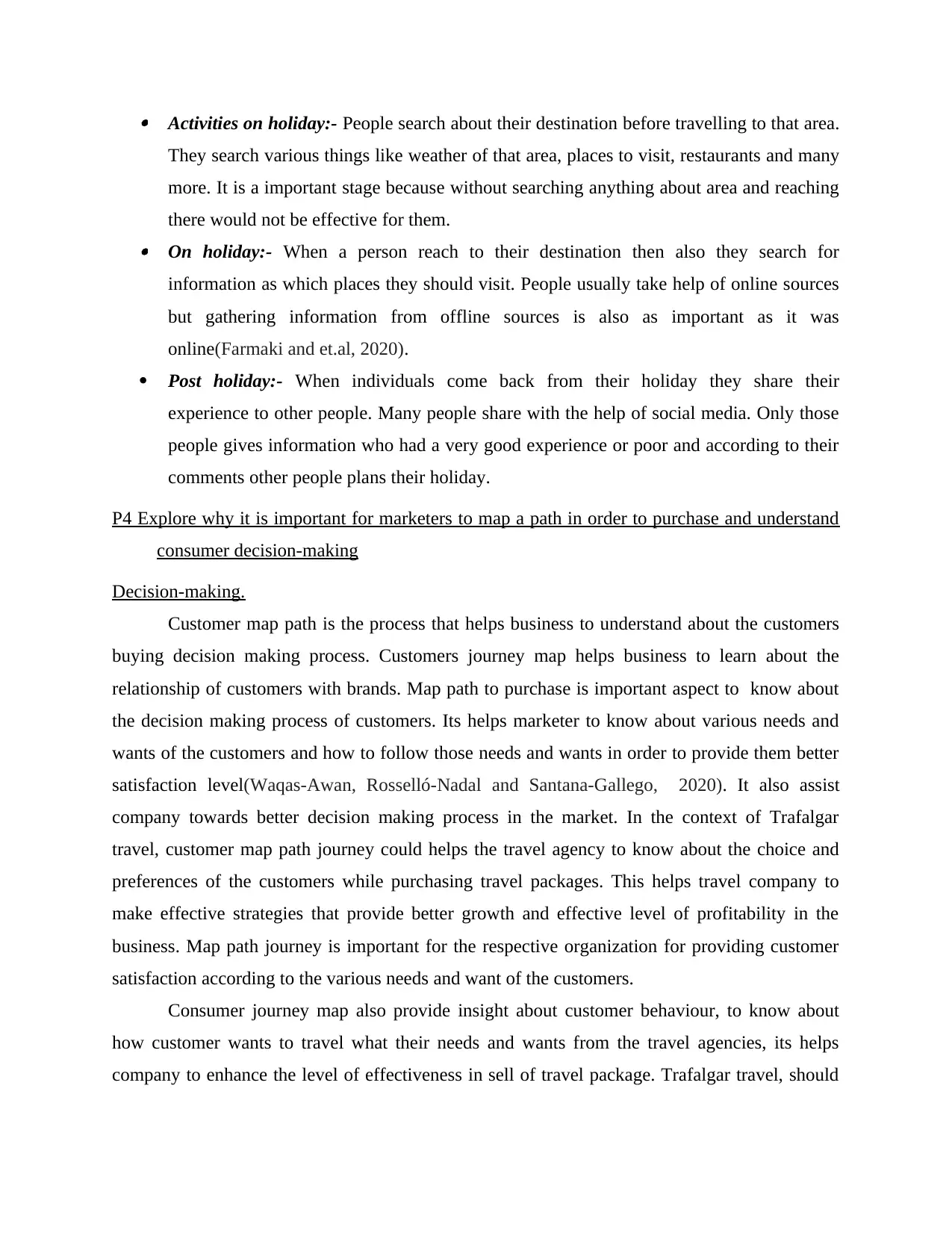
Activities on holiday:- People search about their destination before travelling to that area.
They search various things like weather of that area, places to visit, restaurants and many
more. It is a important stage because without searching anything about area and reaching
there would not be effective for them. On holiday:- When a person reach to their destination then also they search for
information as which places they should visit. People usually take help of online sources
but gathering information from offline sources is also as important as it was
online(Farmaki and et.al, 2020).
Post holiday:- When individuals come back from their holiday they share their
experience to other people. Many people share with the help of social media. Only those
people gives information who had a very good experience or poor and according to their
comments other people plans their holiday.
P4 Explore why it is important for marketers to map a path in order to purchase and understand
consumer decision-making
Decision-making.
Customer map path is the process that helps business to understand about the customers
buying decision making process. Customers journey map helps business to learn about the
relationship of customers with brands. Map path to purchase is important aspect to know about
the decision making process of customers. Its helps marketer to know about various needs and
wants of the customers and how to follow those needs and wants in order to provide them better
satisfaction level(Waqas-Awan, Rosselló-Nadal and Santana-Gallego, 2020). It also assist
company towards better decision making process in the market. In the context of Trafalgar
travel, customer map path journey could helps the travel agency to know about the choice and
preferences of the customers while purchasing travel packages. This helps travel company to
make effective strategies that provide better growth and effective level of profitability in the
business. Map path journey is important for the respective organization for providing customer
satisfaction according to the various needs and want of the customers.
Consumer journey map also provide insight about customer behaviour, to know about
how customer wants to travel what their needs and wants from the travel agencies, its helps
company to enhance the level of effectiveness in sell of travel package. Trafalgar travel, should
They search various things like weather of that area, places to visit, restaurants and many
more. It is a important stage because without searching anything about area and reaching
there would not be effective for them. On holiday:- When a person reach to their destination then also they search for
information as which places they should visit. People usually take help of online sources
but gathering information from offline sources is also as important as it was
online(Farmaki and et.al, 2020).
Post holiday:- When individuals come back from their holiday they share their
experience to other people. Many people share with the help of social media. Only those
people gives information who had a very good experience or poor and according to their
comments other people plans their holiday.
P4 Explore why it is important for marketers to map a path in order to purchase and understand
consumer decision-making
Decision-making.
Customer map path is the process that helps business to understand about the customers
buying decision making process. Customers journey map helps business to learn about the
relationship of customers with brands. Map path to purchase is important aspect to know about
the decision making process of customers. Its helps marketer to know about various needs and
wants of the customers and how to follow those needs and wants in order to provide them better
satisfaction level(Waqas-Awan, Rosselló-Nadal and Santana-Gallego, 2020). It also assist
company towards better decision making process in the market. In the context of Trafalgar
travel, customer map path journey could helps the travel agency to know about the choice and
preferences of the customers while purchasing travel packages. This helps travel company to
make effective strategies that provide better growth and effective level of profitability in the
business. Map path journey is important for the respective organization for providing customer
satisfaction according to the various needs and want of the customers.
Consumer journey map also provide insight about customer behaviour, to know about
how customer wants to travel what their needs and wants from the travel agencies, its helps
company to enhance the level of effectiveness in sell of travel package. Trafalgar travel, should
Paraphrase This Document
Need a fresh take? Get an instant paraphrase of this document with our AI Paraphraser
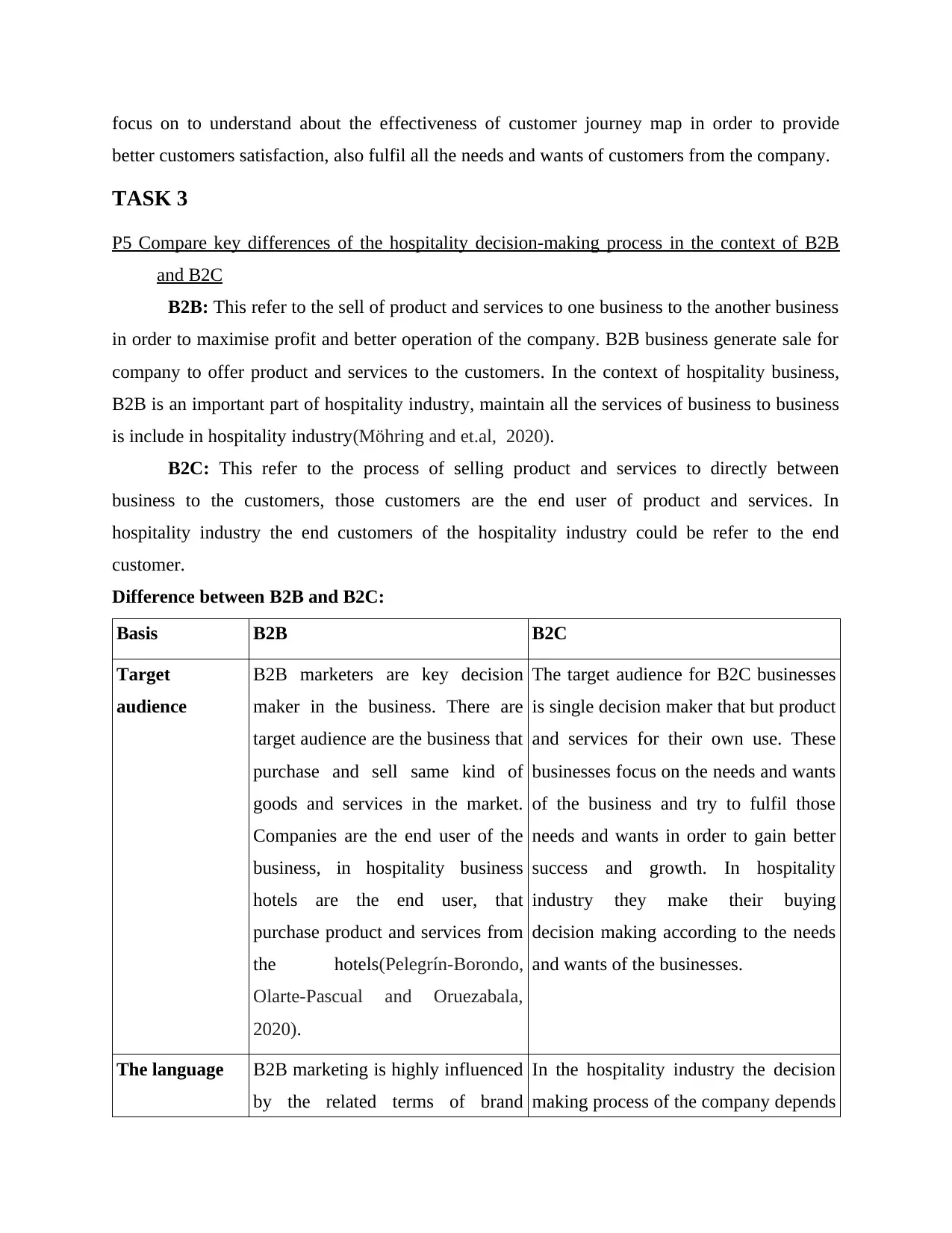
focus on to understand about the effectiveness of customer journey map in order to provide
better customers satisfaction, also fulfil all the needs and wants of customers from the company.
TASK 3
P5 Compare key differences of the hospitality decision-making process in the context of B2B
and B2C
B2B: This refer to the sell of product and services to one business to the another business
in order to maximise profit and better operation of the company. B2B business generate sale for
company to offer product and services to the customers. In the context of hospitality business,
B2B is an important part of hospitality industry, maintain all the services of business to business
is include in hospitality industry(Möhring and et.al, 2020).
B2C: This refer to the process of selling product and services to directly between
business to the customers, those customers are the end user of product and services. In
hospitality industry the end customers of the hospitality industry could be refer to the end
customer.
Difference between B2B and B2C:
Basis B2B B2C
Target
audience
B2B marketers are key decision
maker in the business. There are
target audience are the business that
purchase and sell same kind of
goods and services in the market.
Companies are the end user of the
business, in hospitality business
hotels are the end user, that
purchase product and services from
the hotels(Pelegrín-Borondo,
Olarte-Pascual and Oruezabala,
2020).
The target audience for B2C businesses
is single decision maker that but product
and services for their own use. These
businesses focus on the needs and wants
of the business and try to fulfil those
needs and wants in order to gain better
success and growth. In hospitality
industry they make their buying
decision making according to the needs
and wants of the businesses.
The language B2B marketing is highly influenced
by the related terms of brand
In the hospitality industry the decision
making process of the company depends
better customers satisfaction, also fulfil all the needs and wants of customers from the company.
TASK 3
P5 Compare key differences of the hospitality decision-making process in the context of B2B
and B2C
B2B: This refer to the sell of product and services to one business to the another business
in order to maximise profit and better operation of the company. B2B business generate sale for
company to offer product and services to the customers. In the context of hospitality business,
B2B is an important part of hospitality industry, maintain all the services of business to business
is include in hospitality industry(Möhring and et.al, 2020).
B2C: This refer to the process of selling product and services to directly between
business to the customers, those customers are the end user of product and services. In
hospitality industry the end customers of the hospitality industry could be refer to the end
customer.
Difference between B2B and B2C:
Basis B2B B2C
Target
audience
B2B marketers are key decision
maker in the business. There are
target audience are the business that
purchase and sell same kind of
goods and services in the market.
Companies are the end user of the
business, in hospitality business
hotels are the end user, that
purchase product and services from
the hotels(Pelegrín-Borondo,
Olarte-Pascual and Oruezabala,
2020).
The target audience for B2C businesses
is single decision maker that but product
and services for their own use. These
businesses focus on the needs and wants
of the business and try to fulfil those
needs and wants in order to gain better
success and growth. In hospitality
industry they make their buying
decision making according to the needs
and wants of the businesses.
The language B2B marketing is highly influenced
by the related terms of brand
In the hospitality industry the decision
making process of the company depends
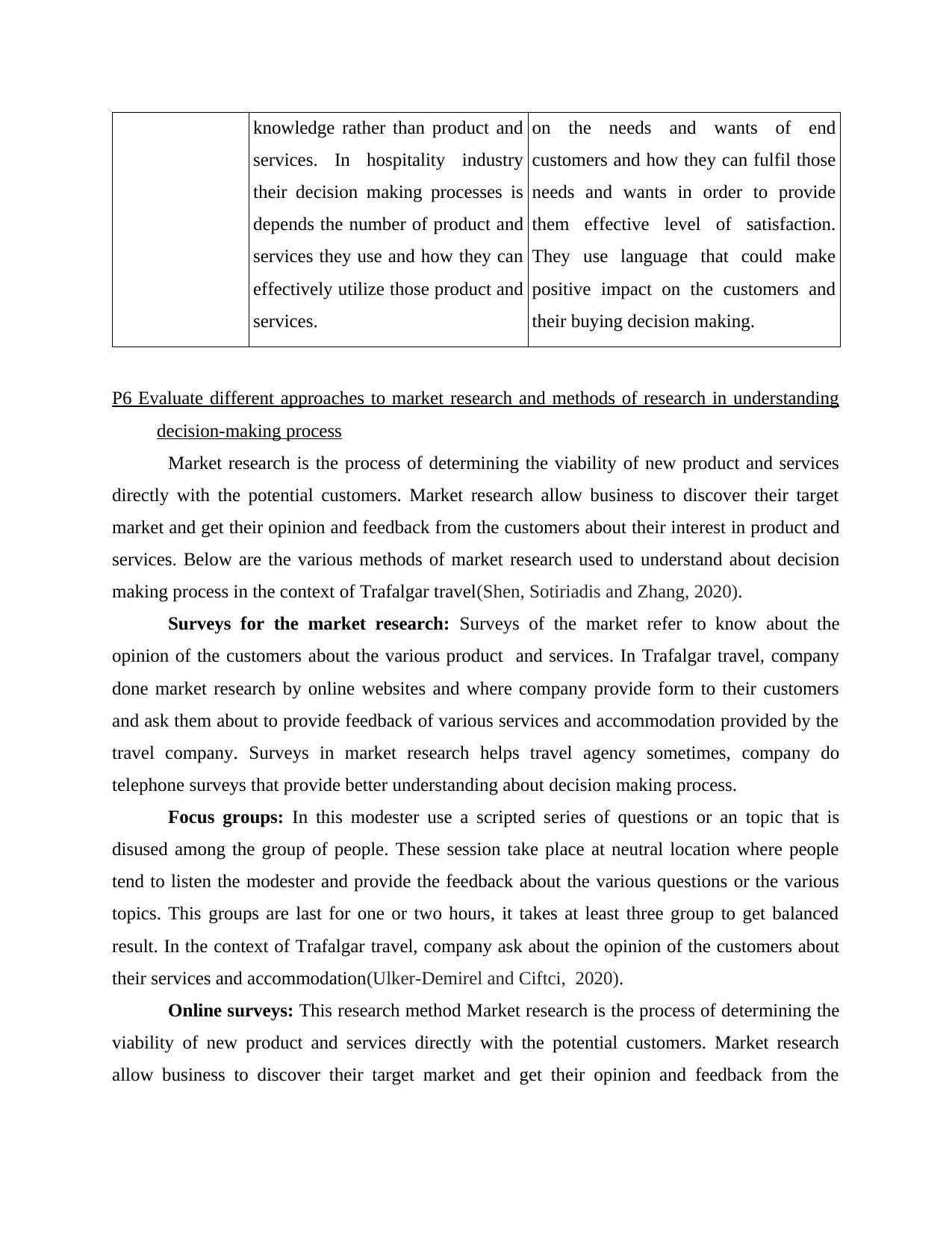
knowledge rather than product and
services. In hospitality industry
their decision making processes is
depends the number of product and
services they use and how they can
effectively utilize those product and
services.
on the needs and wants of end
customers and how they can fulfil those
needs and wants in order to provide
them effective level of satisfaction.
They use language that could make
positive impact on the customers and
their buying decision making.
P6 Evaluate different approaches to market research and methods of research in understanding
decision-making process
Market research is the process of determining the viability of new product and services
directly with the potential customers. Market research allow business to discover their target
market and get their opinion and feedback from the customers about their interest in product and
services. Below are the various methods of market research used to understand about decision
making process in the context of Trafalgar travel(Shen, Sotiriadis and Zhang, 2020).
Surveys for the market research: Surveys of the market refer to know about the
opinion of the customers about the various product and services. In Trafalgar travel, company
done market research by online websites and where company provide form to their customers
and ask them about to provide feedback of various services and accommodation provided by the
travel company. Surveys in market research helps travel agency sometimes, company do
telephone surveys that provide better understanding about decision making process.
Focus groups: In this modester use a scripted series of questions or an topic that is
disused among the group of people. These session take place at neutral location where people
tend to listen the modester and provide the feedback about the various questions or the various
topics. This groups are last for one or two hours, it takes at least three group to get balanced
result. In the context of Trafalgar travel, company ask about the opinion of the customers about
their services and accommodation(Ulker-Demirel and Ciftci, 2020).
Online surveys: This research method Market research is the process of determining the
viability of new product and services directly with the potential customers. Market research
allow business to discover their target market and get their opinion and feedback from the
services. In hospitality industry
their decision making processes is
depends the number of product and
services they use and how they can
effectively utilize those product and
services.
on the needs and wants of end
customers and how they can fulfil those
needs and wants in order to provide
them effective level of satisfaction.
They use language that could make
positive impact on the customers and
their buying decision making.
P6 Evaluate different approaches to market research and methods of research in understanding
decision-making process
Market research is the process of determining the viability of new product and services
directly with the potential customers. Market research allow business to discover their target
market and get their opinion and feedback from the customers about their interest in product and
services. Below are the various methods of market research used to understand about decision
making process in the context of Trafalgar travel(Shen, Sotiriadis and Zhang, 2020).
Surveys for the market research: Surveys of the market refer to know about the
opinion of the customers about the various product and services. In Trafalgar travel, company
done market research by online websites and where company provide form to their customers
and ask them about to provide feedback of various services and accommodation provided by the
travel company. Surveys in market research helps travel agency sometimes, company do
telephone surveys that provide better understanding about decision making process.
Focus groups: In this modester use a scripted series of questions or an topic that is
disused among the group of people. These session take place at neutral location where people
tend to listen the modester and provide the feedback about the various questions or the various
topics. This groups are last for one or two hours, it takes at least three group to get balanced
result. In the context of Trafalgar travel, company ask about the opinion of the customers about
their services and accommodation(Ulker-Demirel and Ciftci, 2020).
Online surveys: This research method Market research is the process of determining the
viability of new product and services directly with the potential customers. Market research
allow business to discover their target market and get their opinion and feedback from the
⊘ This is a preview!⊘
Do you want full access?
Subscribe today to unlock all pages.

Trusted by 1+ million students worldwide
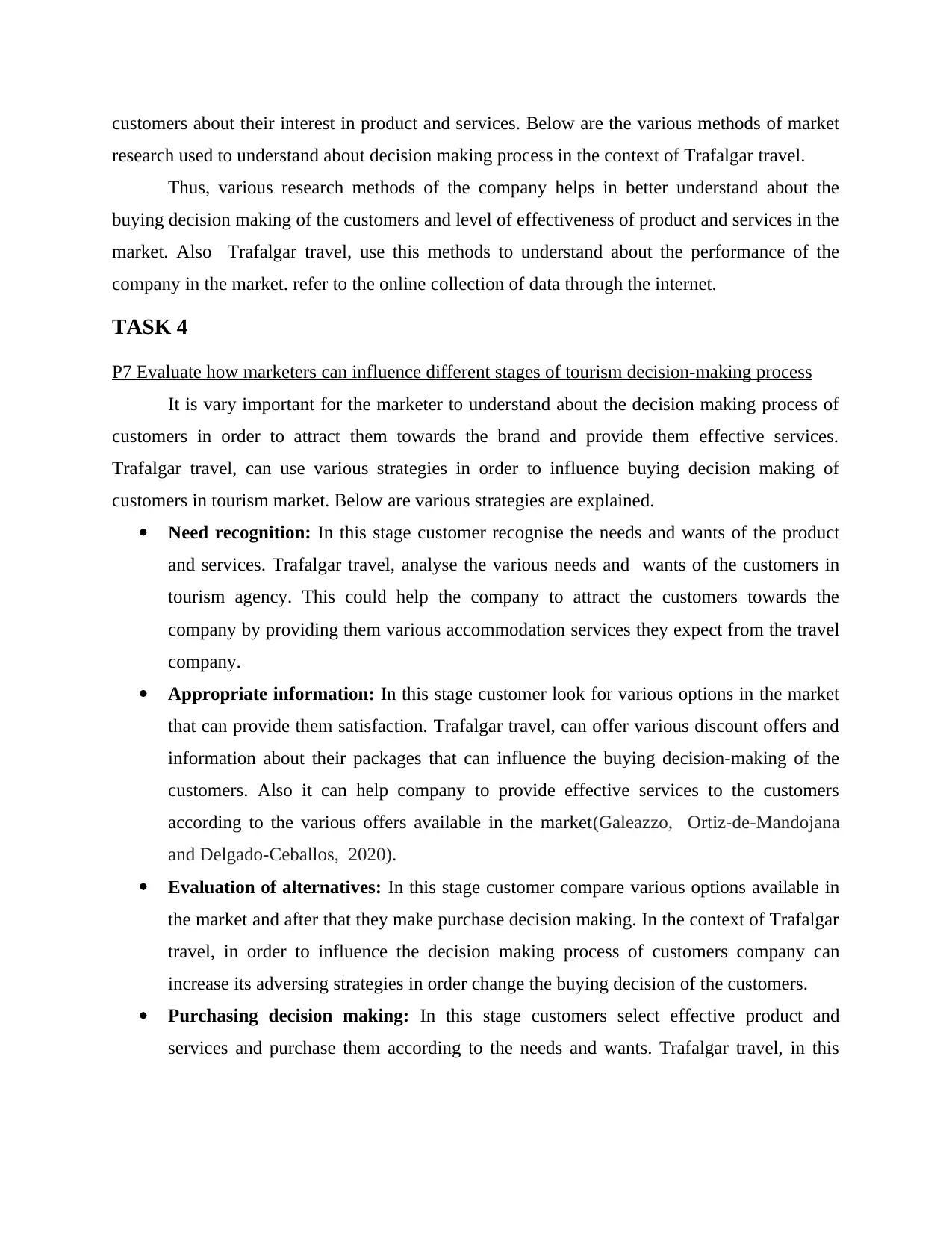
customers about their interest in product and services. Below are the various methods of market
research used to understand about decision making process in the context of Trafalgar travel.
Thus, various research methods of the company helps in better understand about the
buying decision making of the customers and level of effectiveness of product and services in the
market. Also Trafalgar travel, use this methods to understand about the performance of the
company in the market. refer to the online collection of data through the internet.
TASK 4
P7 Evaluate how marketers can influence different stages of tourism decision-making process
It is vary important for the marketer to understand about the decision making process of
customers in order to attract them towards the brand and provide them effective services.
Trafalgar travel, can use various strategies in order to influence buying decision making of
customers in tourism market. Below are various strategies are explained.
Need recognition: In this stage customer recognise the needs and wants of the product
and services. Trafalgar travel, analyse the various needs and wants of the customers in
tourism agency. This could help the company to attract the customers towards the
company by providing them various accommodation services they expect from the travel
company.
Appropriate information: In this stage customer look for various options in the market
that can provide them satisfaction. Trafalgar travel, can offer various discount offers and
information about their packages that can influence the buying decision-making of the
customers. Also it can help company to provide effective services to the customers
according to the various offers available in the market(Galeazzo, Ortiz-de-Mandojana
and Delgado-Ceballos, 2020).
Evaluation of alternatives: In this stage customer compare various options available in
the market and after that they make purchase decision making. In the context of Trafalgar
travel, in order to influence the decision making process of customers company can
increase its adversing strategies in order change the buying decision of the customers.
Purchasing decision making: In this stage customers select effective product and
services and purchase them according to the needs and wants. Trafalgar travel, in this
research used to understand about decision making process in the context of Trafalgar travel.
Thus, various research methods of the company helps in better understand about the
buying decision making of the customers and level of effectiveness of product and services in the
market. Also Trafalgar travel, use this methods to understand about the performance of the
company in the market. refer to the online collection of data through the internet.
TASK 4
P7 Evaluate how marketers can influence different stages of tourism decision-making process
It is vary important for the marketer to understand about the decision making process of
customers in order to attract them towards the brand and provide them effective services.
Trafalgar travel, can use various strategies in order to influence buying decision making of
customers in tourism market. Below are various strategies are explained.
Need recognition: In this stage customer recognise the needs and wants of the product
and services. Trafalgar travel, analyse the various needs and wants of the customers in
tourism agency. This could help the company to attract the customers towards the
company by providing them various accommodation services they expect from the travel
company.
Appropriate information: In this stage customer look for various options in the market
that can provide them satisfaction. Trafalgar travel, can offer various discount offers and
information about their packages that can influence the buying decision-making of the
customers. Also it can help company to provide effective services to the customers
according to the various offers available in the market(Galeazzo, Ortiz-de-Mandojana
and Delgado-Ceballos, 2020).
Evaluation of alternatives: In this stage customer compare various options available in
the market and after that they make purchase decision making. In the context of Trafalgar
travel, in order to influence the decision making process of customers company can
increase its adversing strategies in order change the buying decision of the customers.
Purchasing decision making: In this stage customers select effective product and
services and purchase them according to the needs and wants. Trafalgar travel, in this
Paraphrase This Document
Need a fresh take? Get an instant paraphrase of this document with our AI Paraphraser
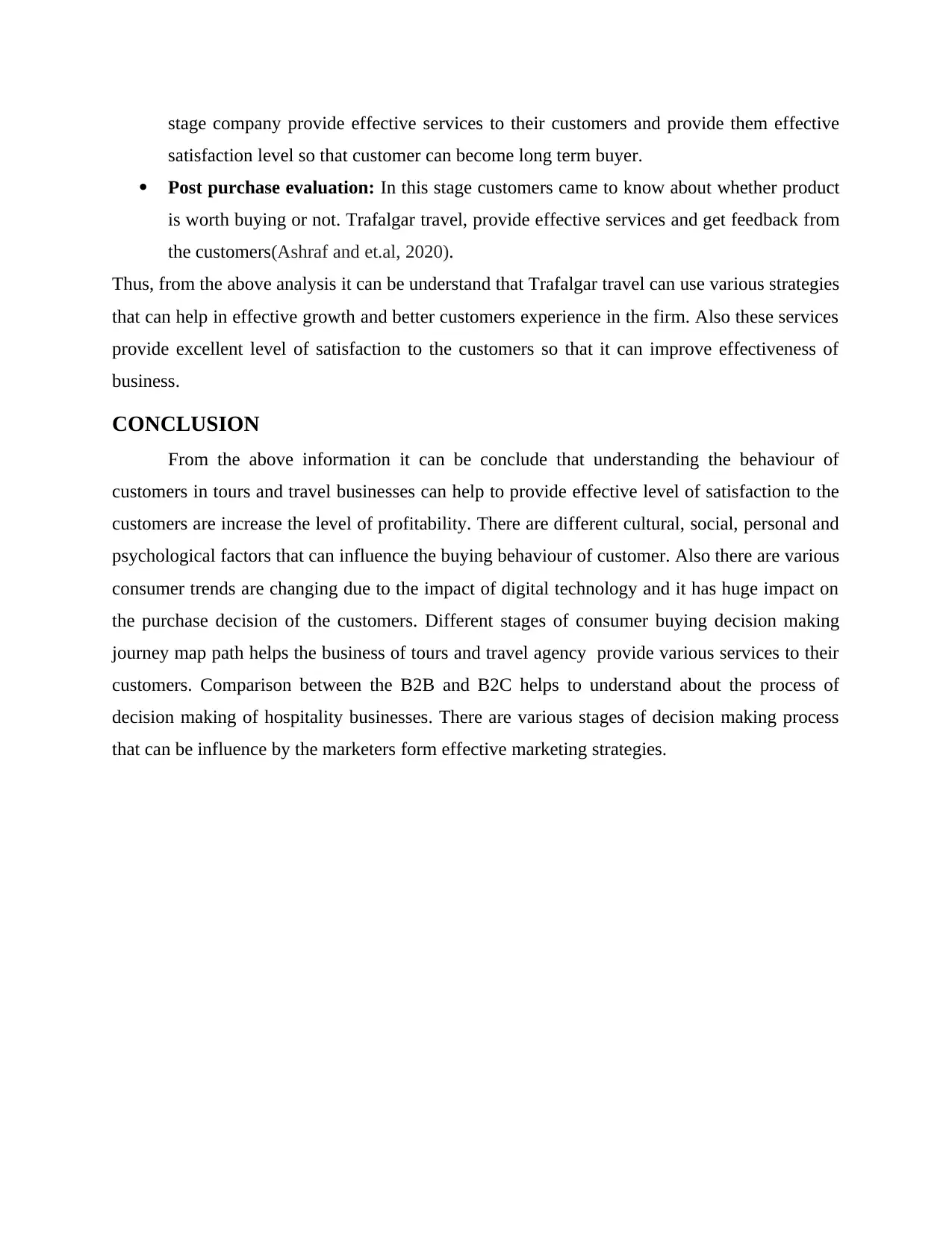
stage company provide effective services to their customers and provide them effective
satisfaction level so that customer can become long term buyer.
Post purchase evaluation: In this stage customers came to know about whether product
is worth buying or not. Trafalgar travel, provide effective services and get feedback from
the customers(Ashraf and et.al, 2020).
Thus, from the above analysis it can be understand that Trafalgar travel can use various strategies
that can help in effective growth and better customers experience in the firm. Also these services
provide excellent level of satisfaction to the customers so that it can improve effectiveness of
business.
CONCLUSION
From the above information it can be conclude that understanding the behaviour of
customers in tours and travel businesses can help to provide effective level of satisfaction to the
customers are increase the level of profitability. There are different cultural, social, personal and
psychological factors that can influence the buying behaviour of customer. Also there are various
consumer trends are changing due to the impact of digital technology and it has huge impact on
the purchase decision of the customers. Different stages of consumer buying decision making
journey map path helps the business of tours and travel agency provide various services to their
customers. Comparison between the B2B and B2C helps to understand about the process of
decision making of hospitality businesses. There are various stages of decision making process
that can be influence by the marketers form effective marketing strategies.
satisfaction level so that customer can become long term buyer.
Post purchase evaluation: In this stage customers came to know about whether product
is worth buying or not. Trafalgar travel, provide effective services and get feedback from
the customers(Ashraf and et.al, 2020).
Thus, from the above analysis it can be understand that Trafalgar travel can use various strategies
that can help in effective growth and better customers experience in the firm. Also these services
provide excellent level of satisfaction to the customers so that it can improve effectiveness of
business.
CONCLUSION
From the above information it can be conclude that understanding the behaviour of
customers in tours and travel businesses can help to provide effective level of satisfaction to the
customers are increase the level of profitability. There are different cultural, social, personal and
psychological factors that can influence the buying behaviour of customer. Also there are various
consumer trends are changing due to the impact of digital technology and it has huge impact on
the purchase decision of the customers. Different stages of consumer buying decision making
journey map path helps the business of tours and travel agency provide various services to their
customers. Comparison between the B2B and B2C helps to understand about the process of
decision making of hospitality businesses. There are various stages of decision making process
that can be influence by the marketers form effective marketing strategies.
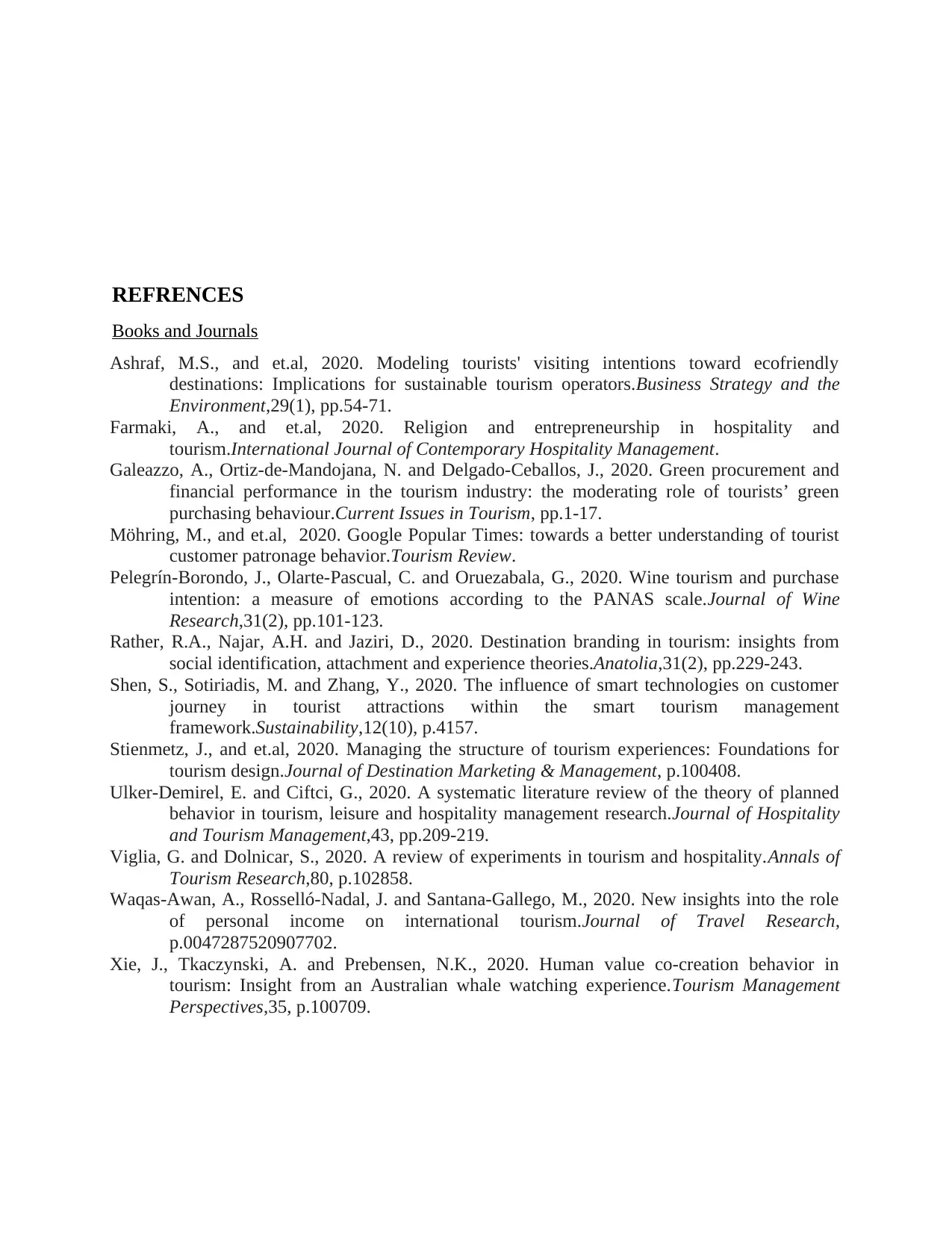
REFRENCES
Books and Journals
Ashraf, M.S., and et.al, 2020. Modeling tourists' visiting intentions toward ecofriendly
destinations: Implications for sustainable tourism operators.Business Strategy and the
Environment,29(1), pp.54-71.
Farmaki, A., and et.al, 2020. Religion and entrepreneurship in hospitality and
tourism.International Journal of Contemporary Hospitality Management.
Galeazzo, A., Ortiz-de-Mandojana, N. and Delgado-Ceballos, J., 2020. Green procurement and
financial performance in the tourism industry: the moderating role of tourists’ green
purchasing behaviour.Current Issues in Tourism, pp.1-17.
Möhring, M., and et.al, 2020. Google Popular Times: towards a better understanding of tourist
customer patronage behavior.Tourism Review.
Pelegrín-Borondo, J., Olarte-Pascual, C. and Oruezabala, G., 2020. Wine tourism and purchase
intention: a measure of emotions according to the PANAS scale.Journal of Wine
Research,31(2), pp.101-123.
Rather, R.A., Najar, A.H. and Jaziri, D., 2020. Destination branding in tourism: insights from
social identification, attachment and experience theories.Anatolia,31(2), pp.229-243.
Shen, S., Sotiriadis, M. and Zhang, Y., 2020. The influence of smart technologies on customer
journey in tourist attractions within the smart tourism management
framework.Sustainability,12(10), p.4157.
Stienmetz, J., and et.al, 2020. Managing the structure of tourism experiences: Foundations for
tourism design.Journal of Destination Marketing & Management, p.100408.
Ulker-Demirel, E. and Ciftci, G., 2020. A systematic literature review of the theory of planned
behavior in tourism, leisure and hospitality management research.Journal of Hospitality
and Tourism Management,43, pp.209-219.
Viglia, G. and Dolnicar, S., 2020. A review of experiments in tourism and hospitality.Annals of
Tourism Research,80, p.102858.
Waqas-Awan, A., Rosselló-Nadal, J. and Santana-Gallego, M., 2020. New insights into the role
of personal income on international tourism.Journal of Travel Research,
p.0047287520907702.
Xie, J., Tkaczynski, A. and Prebensen, N.K., 2020. Human value co-creation behavior in
tourism: Insight from an Australian whale watching experience.Tourism Management
Perspectives,35, p.100709.
Books and Journals
Ashraf, M.S., and et.al, 2020. Modeling tourists' visiting intentions toward ecofriendly
destinations: Implications for sustainable tourism operators.Business Strategy and the
Environment,29(1), pp.54-71.
Farmaki, A., and et.al, 2020. Religion and entrepreneurship in hospitality and
tourism.International Journal of Contemporary Hospitality Management.
Galeazzo, A., Ortiz-de-Mandojana, N. and Delgado-Ceballos, J., 2020. Green procurement and
financial performance in the tourism industry: the moderating role of tourists’ green
purchasing behaviour.Current Issues in Tourism, pp.1-17.
Möhring, M., and et.al, 2020. Google Popular Times: towards a better understanding of tourist
customer patronage behavior.Tourism Review.
Pelegrín-Borondo, J., Olarte-Pascual, C. and Oruezabala, G., 2020. Wine tourism and purchase
intention: a measure of emotions according to the PANAS scale.Journal of Wine
Research,31(2), pp.101-123.
Rather, R.A., Najar, A.H. and Jaziri, D., 2020. Destination branding in tourism: insights from
social identification, attachment and experience theories.Anatolia,31(2), pp.229-243.
Shen, S., Sotiriadis, M. and Zhang, Y., 2020. The influence of smart technologies on customer
journey in tourist attractions within the smart tourism management
framework.Sustainability,12(10), p.4157.
Stienmetz, J., and et.al, 2020. Managing the structure of tourism experiences: Foundations for
tourism design.Journal of Destination Marketing & Management, p.100408.
Ulker-Demirel, E. and Ciftci, G., 2020. A systematic literature review of the theory of planned
behavior in tourism, leisure and hospitality management research.Journal of Hospitality
and Tourism Management,43, pp.209-219.
Viglia, G. and Dolnicar, S., 2020. A review of experiments in tourism and hospitality.Annals of
Tourism Research,80, p.102858.
Waqas-Awan, A., Rosselló-Nadal, J. and Santana-Gallego, M., 2020. New insights into the role
of personal income on international tourism.Journal of Travel Research,
p.0047287520907702.
Xie, J., Tkaczynski, A. and Prebensen, N.K., 2020. Human value co-creation behavior in
tourism: Insight from an Australian whale watching experience.Tourism Management
Perspectives,35, p.100709.
⊘ This is a preview!⊘
Do you want full access?
Subscribe today to unlock all pages.

Trusted by 1+ million students worldwide
1 out of 13
Related Documents
Your All-in-One AI-Powered Toolkit for Academic Success.
+13062052269
info@desklib.com
Available 24*7 on WhatsApp / Email
![[object Object]](/_next/static/media/star-bottom.7253800d.svg)
Unlock your academic potential
Copyright © 2020–2025 A2Z Services. All Rights Reserved. Developed and managed by ZUCOL.




